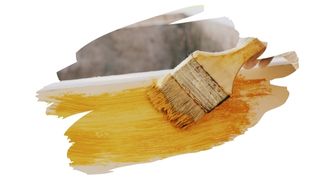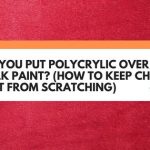Spar Urethane is one of the most water-resistant exterior wood sealers you can easily get your hands on.
This wood sealer is so weatherproof that it’s widely used on outdoor decking and garden furniture.
So, if you want a durable low maintenance way to protect that coat of paint, why wouldn’t you seal it with a few coats of Spar Urethane?
Well, in this post you’ll learn why Spar Urethane is one of the most water-resistant and weatherproof exterior sealants you can use. You’ll also find out if paint even really needs a top coating sealer in the first place.
And keep reading to discover why ‘tacky’ paint is very difficult to seal with Spar Urethane…

This post may contain affiliate links to products that we receive a commission for (at no additional cost to you). Learn more here.
First Off, Does Paint Really Need A Sealer?
Depends on the type of paint.
Most interior paints may need some kind of sealant to protect them from moisture. However, if it is an exterior-graded paint, then it does not need extra safe-guarding.
Exterior paints often have mold-resistant additives and other weatherproofing ingredients. And they make exterior paint a great top coat all on it’s own.
Related Post: Can You Mix Paint And Polyurethane? (Solved!)
But What Do You Put Over Paint To Protect It?
You can use Spar Urethane.
Spar Urethane, (also sometimes known as Spar Varnish or Yacht Varnish), is a very water-resistant urethane-based sealer. Designed primarily for exterior wood, it’s been used to weatherproof outdoor furniture, fences, and even boat decking.
Plus, thanks to added UV-blockers and rot-resistant additives, this low-maintenance finish is one of the most reliable outdoor sealants around.
It has more flexibility to it than polyurethane (which is another urethane-based finish). And this allows Spar Urethane to shrug off scratches and scrapes easily.
All of those reasons are why applying a non-penetrating clear Spar Urethane over paint can be a good idea.
Can Spar Urethane Go Over A Coat Of Latex Paint? A Spray-on water-based urethane will work well over latex paint. But, only if you’ve allowed the latex paint time to dry completely first.
So That Means You Can Use Spar Urethane On Painted Wood, Right?
As long as the coat of paint has both dried and cured, you can coat a non-penetrating Spar Urethane over it.
Now, there are two key caveats here;
1). Use A Spray-On Spar Urethane
When paint dries and cures, it forms a water-repellent seal on the surface of wood.
So a penetrating Spar Urethane isn’t going to work, since it will not be able to sink past paint.
2). The Paint Must Be Cured
Drying and curing are in fact two different processes that paints and finishes go through.
When paint dries, it goes through a process of evaporation turning it from a liquid into a film.
But, a ‘dry’ paint may sometimes still feel tacky to the touch. It may even leach off oils and resins. And it will definitely still be ‘off-gassing’ and releasing fumes into the air.
And this is because the process of curing is still ongoing.
You see, curing is a chemical reaction that takes longer than evaporation. But, it is the curing process that completely changes paint into a durable (yet thin) solid substance.
However, wholly cured paint will not feel soft, won’t feel sticky, and won’t smell of fumes. So that means that the surface of a wholly cured paint is uncontaminated enough for Spar Urethane to adhere to.
What Is Off-Gassing Exactly? Solvent-based paints and sealants often release fumes. These chemical fumes are called VOC’s (Volatile Organic Compounds). And when they release into the air, this is referred to as ‘off-gassing’.
And Can You Use Spar Urethane Over Oil-Paints Too? Or Will It Peel Off?
There are certain types of oil paints that can make it appear as though Spar Urethane will never stick to them.
However, it is curing that’s the real problem — not incompatibility between paint and sealant.
You see, very slow-drying oil paints — especially ones with added Refined Linseed oil — can take weeks (if not months) to cure.
However, an oil-based Spar Urethane will adhere to these oil-paints, but only if you’ve waited for those paints to cure first.
Related Post: A Quick Guide To Painting Landscape Timbers (+ 3 Easy Time Saving Tips!)
What About Tacky Paint? Can You Get Spar Urethane To Stick To It?
Well, Spar Urethane needs to be applied onto a ‘clean’ surface.
What this means is that the surface shouldn’t have wet solvents, greasy oils, or liquid chemicals on it. All of those things can (and often will) prevent the adhesion of Spar Urethane to that surface.
This is why any base coat finish/paint/sealer needs to have already cured first before you go sealing it.
Now, the main problem with tacky paint is that it simply has not cured.
Tacky paints can still leach resins/oils and release VOC’s. And all of those things prevent a Spar Urethane top coat from sticking and staying in place.
Related Post: What’s With All That Sticky Residue Left Behind After Paint Stripping? [Explained!]
To Wrap Up, Here Are The 3 Key Takeaways From This Post…
- 1). Spar Urethane adheres best onto ‘clean’ surfaces that are not contaminated with wet solvents, chemicals or greasy oils.
- 2). If a coat of paint is still tacky, it may still be leaching resins/oils and off-gassing. All of these things prevent Spar Urethane from adhering to tacky paint.
- 3). But, if paint has finished drying and curing, you can use a Spray-On Spar Urethane finish to seal it.
References:
Goehring, L., Li, J., & Kiatkirakajorn, P. C. (2017). Drying paint: from micro-scale dynamics to mechanical instabilities. Philosophical Transactions of the Royal Society A: Mathematical, Physical and Engineering Sciences, 375(2093), 20160161.



